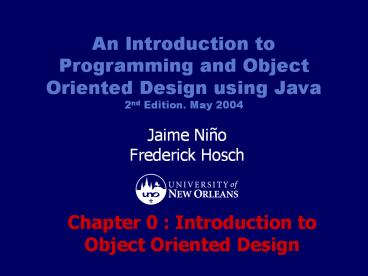Chapter 0 : Introduction to Object Oriented Design - PowerPoint PPT Presentation
Title:
Chapter 0 : Introduction to Object Oriented Design
Description:
Chapter 0 : Introduction to Object Oriented Design ... – PowerPoint PPT presentation
Number of Views:125
Avg rating:3.0/5.0
Title: Chapter 0 : Introduction to Object Oriented Design
1
Chapter 0 Introduction to Object Oriented
Design
2
The science of computing
Computer science is a science of abstraction
creating the right model for a problem and
devising the appropriate mechanizable techniques
to solve it. A. Aho and J. Ullman
3
Objectives
- After studying this chapter you should understand
the following - the nature of software systems
- how abstraction and decomposition are used to
deal with complexity in problems - the fundamental components of a program, data and
functionality - objects, and object-oriented systems and their
relationship to software systems in general.
4
Objectives
- Also, you should be able to
- identify basic components in complex structures
- provide examples of abstraction levels from least
abstract to more abstract - explain how composition and abstraction simplify
the organization of a system - provide informal algorithms for common activities.
5
Nature of a software system
- A software system is a temporary solution to a
changing problem - with two fundamental characteristics
- they are dynamic
- they are complex.
6
Dealing with complexity composition and
abstraction
- Size of software system requires that
- It must be broken down into manageable pieces
- It must be dealt with as a composite structure
- Its parts must interact together
- The more parts the more interaction
- System complexity is proportional to the number
of parts
7
Dealing with complexity composition and
abstraction
- composition
- - process of building a system using simpler
parts or components
8
Dealing with complexity composition and
abstraction
- Abstraction can deal with system components with
no worry about details of how components are
constructed - Abstraction
- process of ignoring details irrelevant to problem
at hand - emphasizes essential ones
- to abstract is to disregard certain
differentiating details
9
Two aspects of a system data and
functionality
- data information program deals with
- data descriptions are fixed,
- individual data values may change each time
program runs
10
Two aspects of a system data and
functionality
- functionality what the program does with data
- computation a goal-directed sequence of actions
performed by a processor - algorithm set of instructions describing pattern
of behavior guaranteed to achieve a goal
11
Object-oriented systems
- Use the Object Oriented approach for structuring
systems - Intended to produce systems that are ...
- composite
- modular
- built using abstraction
- organized around data
12
Object-oriented systems
- Objects abstractions used to describe the
problem - Functionality of system is distributed to the
objects - each object has algorithms to accomplish specific
tasks
13
Summary
- Software systems are complex
- Software systems are dynamic
- To address these difficulties
- make extensive use of abstraction
- build systems that are modular, and composite.
14
Summary
- To define a software system, we will include
- a description of the data items to be manipulated
by the system, and - a collection of algorithms that provide the
systems functionality - We adopt an object-based methodology that
structures the system around the data

